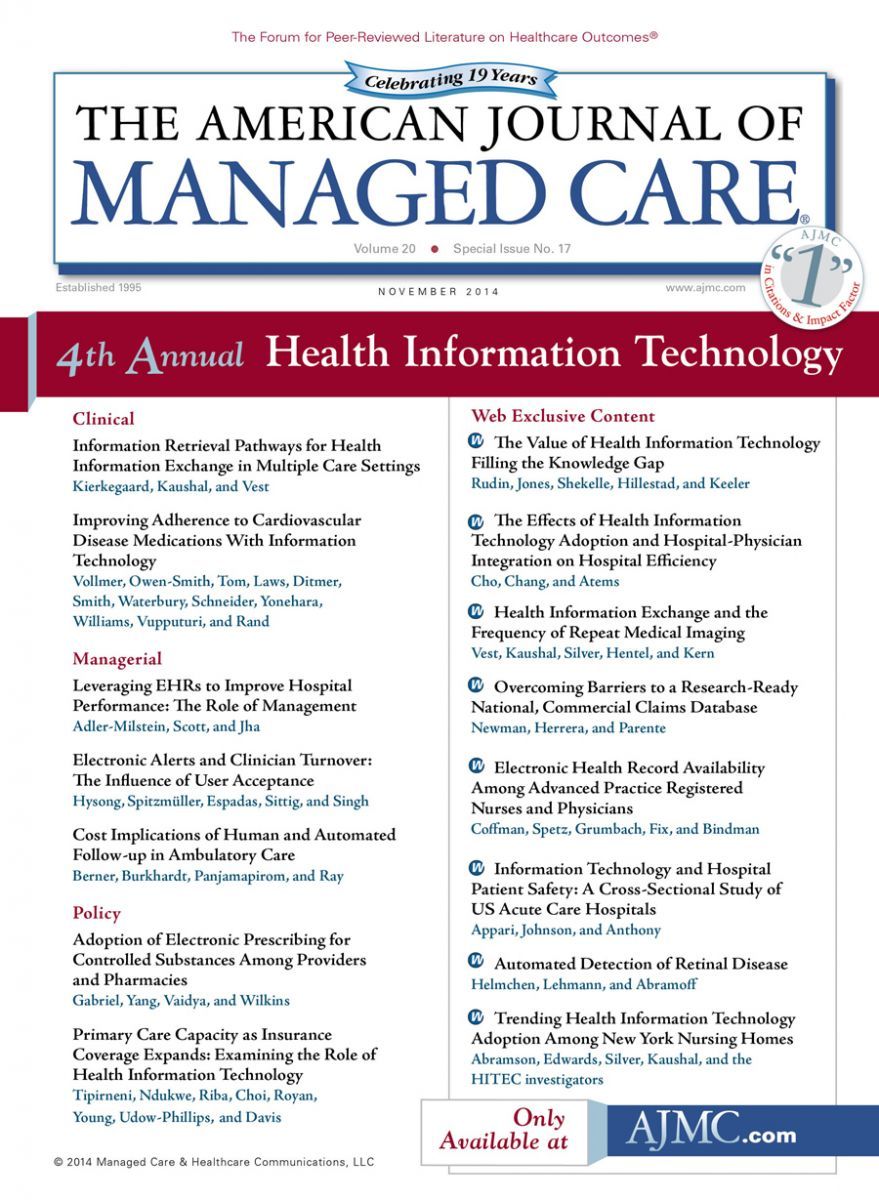- Center on Health Equity & Access
- Clinical
- Health Care Cost
- Health Care Delivery
- Insurance
- Policy
- Technology
- Value-Based Care
The 3 Key Themes in Health Information Technology
This year's special issue on Health Information Technology (HIT) features an impressive body of new research that reflects progress in the field along an array of dimensions-new timely questions, emerging sources of data, and novel methodologies applied to HIT.
Am J Manag Care. 2014;20(Spec. No. 17):SP492-SP493
Each year the Health Information Technology (HIT) Special Issue of The American Journal of Managed Care features an impressive body of new research that reflects progress in the field along an array of dimensions—new timely questions, emerging sources of data, and novel methodologies applied to HIT. This year is no exception. While each of the 15 articles makes a unique and distinct contribution across a wide range of topic areas, they coalesce around 3 key themes.
First, adoption of HIT is growing rapidly in some domains, but only inching upward in others and settings.
Gabriel and colleagues use SureScripts data to show a dramatic national increase in electronic prescribing of controlled substances following legalization of such prescribing by the Drug Enforcement Administration. In contrast, Abramson and colleagues find slow adoption of electronic health records (EHRs) as well as health information exchange (HIE) among nursing homes in New York state. Coffman and colleagues examine EHR availability among certified nurse midwives, nurse practitioners, and physicians in California, one of the first studies to specifically examine adoption among advanced practice nurses. They find similar rates of adoption for basic EHRs but lower rates of advanced EHR adoption among advanced practice nurses, which appear to be driven by lower odds of these nurses practicing in hospital settings. Kierkegaard and colleagues examine HIE adoption in 3 settings—EDs, primary care practices, and public health clinics—and uncover a complex combination of pathways used to electronically obtain clinical information from external organizations. This snapshot of the challenges when using available HIE capabilities offers valuable insights into the work that lies ahead to ensure that greater electronic access to information across settings translates into improved care delivery.
The second key theme is the growing evidence of the impact of HIT on important outcomes such as patient safety as well as for reducing the cost of care and care delivery.
Using data from US hospitals, Appari and colleagues find an association between use of health IT and modestly lower rates of adverse patient safety outcomes for inpatient and surgical care. Meanwhile, Vest and colleagues find an association between usage of a point-of-care HIE system and fewer repeat imaging procedures among commercially insured adults in an 11-county region in New York.
Particularly notable is a cluster of 3 papers that assesses the potential to substitute less costly health IT for more costly human time to deliver valuable health interventions. Berner and colleagues use models to project the costs of human versus IVR-based follow-up processes in ambulatory care. Vollmer and colleagues conducted a randomized trial to assess the impact of low-cost EHR-linked telephone reminders (compared with usual care) on long-term medication adherence. They find a small but statistically significant improvement in adherence for patients with cardiovascular disease. Finally, Helmchen and colleagues argue for greater reliance on automated retinal screening, which offers a low-cost option to meet the growing demand for routine screening services.
The third key theme is the exploration of contextual factors that shape the magnitude of HIT impact as well as lead to potential unintended consequences.
This theme is evident in the framework for assessing the value of HIT offered by Rudin and colleagues, which makes a strong case for systematically capturing contextual and implementation characteristics alongside more complete measures of value. Adhering to such a framework would make future studies significantly more useful for policy makers and practitioners alike. Adler-Milstein and colleagues find evidence that a particular contextual factor—the quality of hospital management—modifies the relationship between EHR adoption and key performance outcomes in a sample of US hospitals. Chang and colleagues focus on a different context factor—hospital-physician integration—and find that, while both HIT adoption and integration are independently associated with hospital efficiency, in combination they serve as substitutes.
With regard to unintended consequences, Hysong and colleagues discover that certain dimensions of EHR-based asynchronous alerts are negatively associated with primary care provider satisfaction and intention to quit, which could result in turnover. The article by Tipirneni and colleagues points to a second unintended consequence of HIT adoption—less capacity among primary care practices to accept new patients, which is a particular concern against the backdrop of ACA-driven insurance expansion.
The final article in the special issue addresses a key HIT frontier. Herrera and colleagues discuss lessons learned about data governance and distribution from a voluntary repository of national commercial claims data, and the implications for future “big data” efforts in healthcare. With the massive amount of administrative and clinical data generated daily across our healthcare system, these lessons are particularly important to ensure that the data can be securely and effectively used by researchers and policy makers. If this happens, we can expect that next year’s Special Issue will reflect the long-awaited transition from big data hype to reality.


